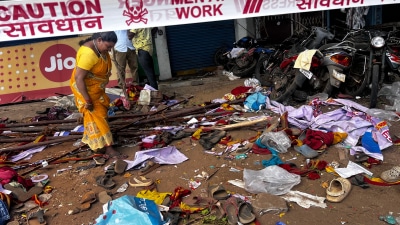The power of the pitch
The latest diatribe from Mathew Engel's pen against Jagmohan Dalmiya, dipped in the `hallowed ink' of The Lord's and written in cricket's...

The latest diatribe from Mathew Engel’s pen against Jagmohan Dalmiya, dipped in the `hallowed ink’ of The Lord’s and written in cricket’s bible, The Wisden, should not come as a surprise to those who have watched the growing discomfiture of the `White’ world at their supremacy getting eroded by market forces.
Ever since the 1996 World Cup was allotted to India — despite fierce opposition from England — and the appointment of an Indian as president of the International Cricket Conference in 1997, Calcutta and not The Lord’s, has become the headquarters of the cricketing establishment. The conservative British establishment has still not accepted this reality. Everything may seem fair in this Black and White war, even allegations of cheating, manipulation, stealth and bribery. And the one man who represents everything which the British fear — from loss of power and prestige to loss of economic power — is Dalmiya, who not only controls the ICC but also Indian cricket, the place where all the moneyfor the game is.
This 59-year-old Marwari from Bengal is the undoubted king of world cricket at the moment, displaying his wares by hosting one tournament after the other in places as disparate as Singapore, Nepal and Bangladesh, collecting millions in the process.
This year, by successfully hosting the Mini World Cup in Bangladesh — still not a full-fledged member of the ICC — Dalmiya proved once again that when it comes to organisational skills and raising money, he has few peers in the sporting world.
No one was complaining about the choice of venue, for the money raised was in crores and the ostensible reason for the series was to keep ICC’s coffers healthy.
Dalmiya’s rise to power is interesting. There was a time when he and Inderjeet Singh Bindra, former president of the Board of Control for Cricket in India, were partners-in-arms. The partnership was mutually beneficial. Bindra, an IAS officer from Punjab, had the power of the bureaucracy behind him and Dalmiya brought into play all themanipulative skills of a businessman in the duo’s struggle for power within the BCCI. It was a partnership which saw Dalmiya become the secretary of the Board and Bindra the president.
The two `inseparables’ pooled their skills together and were largely responsible for ushering in a new era in Indian cricket. An era which saw the Board fighting Doordarshan tooth and nail in 1994, to break its monopoly over the telecasting rights of the game. The matter went up to the Supreme Court and the Board won the battle. The rights of televising Indian cricket were sold to Trans World International (TWI), a production company, and ESPN Inc. for five years (1994-1998) for a whopping amount of $35 million (estimated). It ensured the Board an annual income of Rs 20 crore.
Television revolutionised the game in India and changed its very face. From a deficit of Rs 81.60 lakh in 1992-93, the Board registered a profit of Rs 16 crore in 1997-98. As the money generating capacity of the Board grew and Indian cricket became aglobal institution because of it, Dalmiya’s stature too acquired larger-than-life dimensions. It was this that gave him the confidence to challenge the supremacy of the White cricket world and stake his claim to ICC’s presidentship. The establishment squirmed.
It had faced a similar situation in 1993, when ICC delegates had gathered at The Lord’s to decide the venue of the 1996 World Cup. As in the case for the 1987 World Cup, the sub-continent had made a joint bid and offered money to the tune of Å“200,000 in total prize money, plus Å“250,000 to each full Test member, Å“125,000 to each of the three qualifying associate members and Å“100,000 to each of the other 16 associate members. England offered more or less, a similar amount of money, except that the distribution was different, with the associate member’s share being Å“65,000.
In the Indian delegation was Dalmiya, in his capacity as the secretary of the BCCI. India won the bid, to the chagrin of England which had tried its best to prevent the Cup goingaway from them. They even resorted to changing the voting pattern from a simple majority to two-thirds of the full members so that associate members wouldn’t have a decisive say. After some bitter wrangling, England finally withdrew its bid on the condition that in future the venue would be rotated. But the cricket world had got so divided over the issue that the British media even rued the fact that “cricket is becoming increasingly the province of third world politicians whose concern for the good of the game is subservient to their lust for power and influence.”
Bitter squabbles of this kind also marked the elections for the ICC presidentship, which took place in 1997. But, finally, the new globalised reality that had catapulted the Indian Board to riches, had to be recognised. Dalmiya became the president of the ICC and that’s how The Lord’s lost its position as the headquarters of the game.
This loss of power must still be galling to England. That’s probably why anything which belittles Dalmiya andthe Indian Board comes in handy for the English press. The elevation of Dalmiya had its fallout in India too. The two `best friends’ became `enemies’: Dalmiya and Bindra fell apart. The exact reasons for this are not known but, presumably, the desire to wield power caused the rift.
Dalmiya, despite holding no post in the Indian Board now, showed his acumen as the cleverer `operator’ than Bindra and helped his henchmen — Jaywant Lele and Rajsingh Dungarpur — become the secretary and president of the Board by defeating people handpicked by Bindra in the BCCI elections at Chennai in 1997.
Today Dalmiya, who has been in control of the Cricket Association of Bengal (CAB) for more than a decade now, is ruling Indian cricket by proxy. Once his term in the ICC ends, he has the backing of the majority of the 31 members of the BCCI and can become its president. The support is largely due to what his friends describe as an “ability to oblige and distribute largesse to gain favours”, be it in the BCCI or theICC.
Engel’s outpourings in The Wisden that Dalmiya should quit as ICC president because of the betting and bribery scandal, that had surfaced during his tenure, was not handled properly, should be understood against this backdrop. But, at the same time, it must be said that Dalmiya’s record as the secretary of the Board in handling “match-fixing” charges against Indian cricketers is very poor.
After much dillydallying, former Chief Justice of India, Y.V. Chandrachud was appointed to probe the whole issue and today it is widely believed that his findings were more of an eyewash than a serious attempt to discover the truth.
Now that the whole issue has resurfaced, with the Australian duo of Shane Warne and Mark Waugh admitting that they had accepted money from an Indian bookie in 1994 and Pakistan making concerted efforts to uncover the scandal, the pressure on the ICC to get to the bottom of this murky affair has increased considerably.
Dalmiya has earned a lot of goodwill from players likeIan Chappell and Tony Greig, who call him a visionary because of his efforts in trying to spread the game and make ICC a cash-rich body. It is a goodwill he should not fritter away. He must make his money-making activities more transparent and also, as he promised just before the Christchurch meeting of the ICC in February this year, he must do his best “to cleanse the game of this stigma”. Otherwise, it is The Lord’s establishment that will have had the last laugh.
Photos







- 01
- 02
- 03
- 04
- 05
























